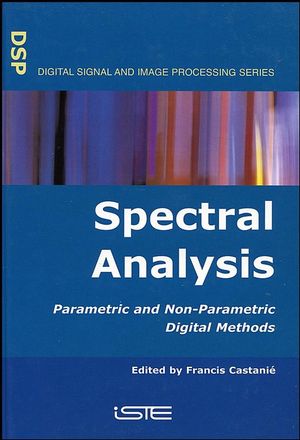Spectral Analysis: Parametric and Non-Parametric Digital MethodsISBN: 978-1-905209-05-7
Hardcover
264 pages
June 2006, Wiley-ISTE
 |
||||||
Preface 9
Specific Notations 13
PART I. Tools and Spectral Analysis 15
Chapter 1. Fundamentals 17
Francis CASTANIÉ
1.1. Classes of signals 17
1.1.1. Deterministic signals 17
1.1.2. Random signals 20
1.2. Representations of signals 23
1.2.1. Representations of deterministic signals 23
1.2.1.1. Complete representations 23
1.2.1.2. Partial representations 25
1.2.2. Representations of random signals 27
1.2.2.1. General approach 27
1.2.2.2. 2nd order representations 28
1.2.2.3. Higher order representations 32
1.3. Spectral analysis: position of the problem 33
1.4. Bibliography 35
Chapter 2. Digital Signal Processing 37
Éric LE CARPENTIER
2.1. Introduction 37
2.2. Transform properties 38
2.2.1. Some useful functions and series 38
2.2.2. Fourier transform 43
2.2.3. Fundamental properties 47
2.2.4. Convolution sum 48
2.2.5. Energy conservation (Parseval’s theorem) 50
2.2.6. Other properties 51
2.2.7. Examples 53
2.2.8. Sampling 55
2.2.9. Practical calculation, FFT 59
2.3. Windows 62
2.4. Examples of application 71
2.4.1. LTI systems identification 71
2.4.2. Monitoring spectral lines 75
2.4.3. Spectral analysis of the coefficient of tide fluctuation 76
2.5. Bibliography 78
Chapter 3. Estimation in Spectral Analysis 79
Olivier BESSON and André FERRARI
3.1. Introduction to estimation 79
3.1.1. Formalization of the problem 79
3.1.2. Cramér-Rao bounds 81
3.1.3. Sequence of estimators 86
3.1.4. Maximum likelihood estimation 89
3.2. Estimation of 1st and 2nd order moments 92
3.3. Periodogram analysis 97
3.4. Analysis of estimators based on cˆxx m?n101
3.4.1. Estimation of parameters of an AR model 103
3.4.2. Estimation of a noisy cisoid by MUSIC 106
3.5. Conclusion 108
3.6. Bibliography 108
Chapter 4. Time-Series Models 111
Francis CASTANIÉ
4.1. Introduction 111
4.2. Linear models 113
4.2.1. Stationary linear models 113
4.2.2. Properties 116
4.2.2.1. Stationarity 116
4.2.2.2. Moments and spectra 117
4.2.2.3. Relation with Wold’s decomposition 119
4.2.3. Non-stationary linear models 120
4.3. Exponential models 123
4.3.1. Deterministic model 123
4.3.2. Noisy deterministic model 124
4.3.3. Models of random stationary signals 125
4.4. Non-linear models 126
4.5. Bibliography 126
PART II. Non-Parametric Methods 129
Chapter 5. Non-Parametric Methods 131
Éric LE CARPENTIER
5.1. Introduction 131
5.2. Estimation of the power spectral density 136
5.2.1. Filter bank method 136
5.2.2. Periodogram method 139
5.2.3. Periodogram variants 142
5.3. Generalization to higher order spectra 146
5.4. Bibliography 148
PART III. Parametric Methods 149
Chapter 6. Spectral Analysis by Stationary Time Series
Modeling 151
Corinne MAILHES and Francis CASTANIÉ
6.1. Parametric models 151
6.2. Estimation of model parameters 153
6.2.1. Estimation of AR parameters 153
6.2.2. Estimation of ARMA parameters 160
6.2.3. Estimation of Prony parameters 161
6.2.4. Order selection criteria 164
6.3. Properties of spectral estimators produced 167
6.4. Bibliography 172
Chapter 7. Minimum Variance 175
Nadine MARTIN
7.1. Principle of the MV method 179
7.2. Properties of the MV estimator 182
7.2.1. Expressions of the MV filter 182
7.2.2. Probability density of the MV estimator 186
7.2.3. Frequency resolution of the MV estimator 192
7.3. Link with the Fourier estimators 193
7.4. Link with a maximum likelihood estimator 196
7.5. Lagunas methods: normalized and generalized MV 198
7.5.1. Principle of normalized MV 198
7.5.2. Spectral refinement of the NMV estimator 200
7.5.3. Convergence of the NMV estimator 202
7.5.4. Generalized MV estimator 204
7.6. The CAPNORM estimator 206
7.7. Bibliography 209
Chapter 8. Subspace-based Estimators 213
Sylvie MARCOS
8.1. Model, concept of subspace, definition of high resolution 213
8.1.1. Model of signals 213
8.1.2. Concept of subspaces 214
8.1.3. Definition of high-resolution 216
8.1.4. Link with spatial analysis or array processing 217
8.2. MUSIC 217
8.2.1. Pseudo-spectral version of MUSIC 220
8.2.2. Polynomial version of MUSIC 221
8.3. Determination criteria of the number of complex sine waves 223
8.4. The MinNorm method 224
8.5. “Linear” subspace methods 226
8.5.1. The linear methods 226
8.5.2. The propagator method 226
8.5.2.1. Propagator estimation using least squares technique 228
8.5.2.2. Determination of the propagator in the presence of a white noise 229
8.6. The ESPRIT method 232
8.7. Illustration of subspace-based methods performance 235
8.8. Adaptive research of subspaces 236
8.9. Bibliography 242
Chapter 9. Introduction to Spectral Analysis of
Non-Stationary Random Signals 245
Corinne MAILHES and Francis CASTANIÉ
9.1. Evolutive spectra 246
9.1.1. Definition of the “evolutive spectrum” 246
9.1.2. Evolutive spectrum properties 247
9.2. Non-parametric spectral estimation 248
9.3. Parametric spectral estimation 249
9.3.1. Local stationary postulate 250
9.3.2. Elimination of a stationary condition 251
9.3.3. Application to spectral analysis 254
9.4. Bibliography 255
List of Authors 259
Index 261



